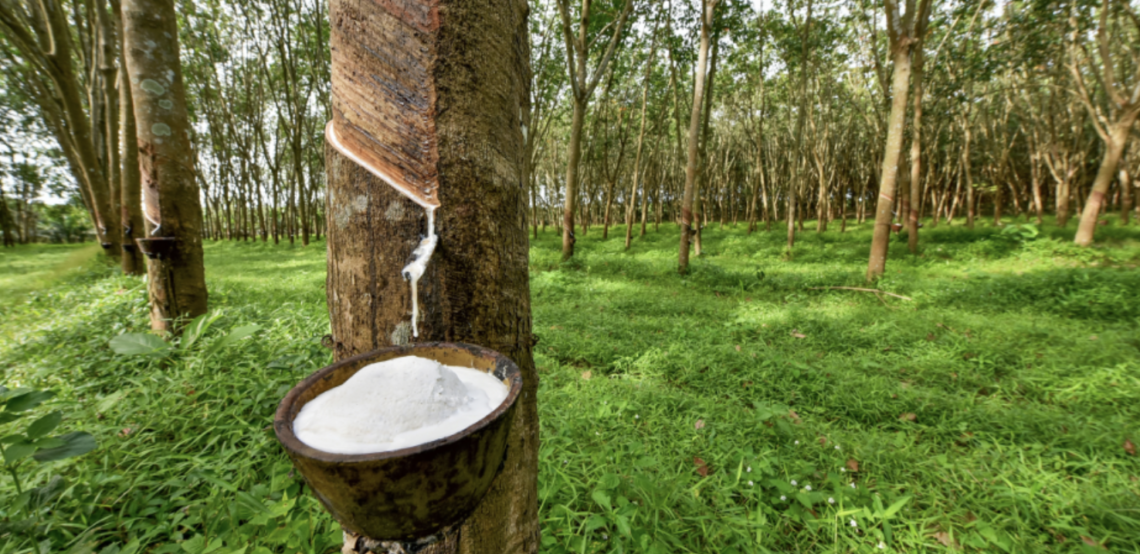Summary
Côte d’Ivoire is a key player in global rubber production, ranking as the 3rd largest producer in the world. The country’s rubber output has seen substantial growth, with production increasing by 113% between 2019 and 2023. This expansion led to significant economic benefits, with rubber exports generating $2 billion in 2023, accounting for 11% of Côte d’Ivoire’s total export value.
The concentration of rubber plantations is mainly in the southern and southwestern regions of the country, where climatic conditions are favorable for cultivation.
Looking to the future, climate change poses both risks and opportunities for Côte d’Ivoire’s rubber industry. Projections based on IPCC climate scenarios suggest that while the country’s Hevea-growing regions will remain below or close to the optimal 28°C threshold until 2040, temperatures are expected to rise above this limit in some areas between 2041 and 2060. After 2061, most of the rubber-growing regions may exceed the 28°C threshold, potentially reducing yields due to higher nighttime temperatures, which negatively impact latex production. Despite this, precipitation levels are expected to remain sufficient for rubber cultivation, even though annual rainfall is projected to decline slightly.
To safeguard the future of rubber production, Côte d’Ivoire needs to adopt adaptation strategies, such as improving agronomic practices, breeding more climate-resilient rubber clones, and expanding cultivation into areas where climate conditions are expected to remain favorable. Given the natural rubber contribution to the economy, proactive measures will be required to ensure its sustainability in the face of changing environmental conditions.
Rubber: an important economic lever
While Indonesia and Thailand alone, with 7.3 million hectares in 2022, represent more than 50% of the world’s rubber tree surface, Africa is the 2nd natural rubber producing region, with 1.5 million ha (11%).1
In Africa, rubber is produced in Côte d’Ivoire, ranked 3rd producer in the world2 with 1.8 million of tons in 2022, and Nigeria, ranked 15th with 150k tons3. Ivorian production is also strongly increasing, with +113% tons produced and exported between 2019 and 2023.4
Rubber and its secondary products generated USD59 millions in export value in 2023 for Nigeria, which represents only 0.1% of its total exports.5 However, it generated 2bn US dollars in export value in 2023 for Côte d’Ivoire, representing 11% of the country’s exported goods.6 Rubber is therefore a very important commodity for the Ivorian economy.
Other countries in the region also produce rubber. Liberia rubber and its products represented 18% of export value in 2020, while for Cameroon and Ghana, natural rubber export represented only around 1% of their total exports value in the last few years, and even less than 0.2% in Gabon and DRC.7
Climate change poses a threat to many crops, and economies based on agricultural production are expected to suffer. For example, the area of land suitable for growing Arabica coffee, which makes up 70% of world production, will shrink globally by 50% by 2050 due to rising temperatures. The Congo Basin could become unsuitable for the cultivation of Robusta coffee, which makes up the other 30% of production.8
The demand for natural rubber will continue to increase, yet the indices of climate change, such as increasing temperature and reduced rainfall will adversely affect rubber production in Cote d’Ivoire9;10;11.However, the climate change has opportunities for rubber cultivation such as expansion of rubber cultivation to areas that may become favorable due to climate change. Breeding for climate resilience in Hevea and improved farm practice will ensure sustainable and increasing production of natural rubber in Côte d’Ivoire.
While the economic importance of Hevea cultivation is lower than in Côte d’Ivoire, the climatic evolutions could prove favorable to extend cultivation, and opportunities may be explored in rubber producing countries in West Africa: Liberia, Côte d’Ivoire, Ghana, Nigeria and Cameroon.12;13;14
Increased temperatures and altered rainfall patterns disrupt Hevea cultivation
Optimum weather conditions for rubber trees (Hevea brasiliensis) cultivation are ±28°C mean annual temperature, relative humidity of 67-82%, and rainfall of 1400-4000 mm distributed over 100-182 days.15
Climate change already impacts rubber growth in some regions.
• Changes in rain quantity and patterns threaten the survival of young plants and droughts can delay trees growth. Conversely, precipitation may increase in some areas, leading to soil erosion and waterlogging.16
• Areas with temperatures above 28°C are not considered suitable, and global warming will likely modify the suitable growing areas.17;18
• Extreme weather events can create extensive damages in plantations.19 • Pests and diseases affecting rubber are also markedly influenced by climate conditions.20
The changes also impact productivity:
• Latex flow, and especially its duration, is linked to the internal pressure of the latex vessels and is best when temperature is at its lowest. Higher temperatures at nights can affect latex production and negatively impact yields.21 Higher temperatures during the day can also influence tapping.22
• More frequent rains can disrupt tapping, which can only be realized in dry conditions. These modifications will drive a shift of climatically favorable areas.23
Potential opportunity for West Africa
Hevea plantations are typically on the field for 30 to 40 years, since the trees need several years to start producing and are then exploited for 23 to 34 years.24 The decisions to start new plantations, therefore need to consider future climatic conditions.
In Côte d’Ivoire, Hevea plantations are concentrated in the South and South-West regions, where climatic conditions have been favorable. While industrial plantations historically dominated the landscape, smallholders’ farms became prominent in the 2000s, reaching 90%+ in 2018.25 Therefore, individual plantations are not represented in the following maps.
We used the latest CMIP projections to create maps of Côte d’Ivoire showing the forecast until 2080 under 3 climate scenarios for:
• annual average temperatures,
• annual average precipitations,
• maximum temperatures
• precipitations variation.
We considered 3 of the IPCC’s scenario for climate change:
• SSP245, dubbed “Middle of the Road” scenario
• SSP370, a pessimistic scenario nicknamed “Fragmented World”
• SSP585, the “worst-case” high-emissions scenario
Annual average temperature forecast in Côte d’Ivoire, for 3 climate scenarios, 2021- 2080
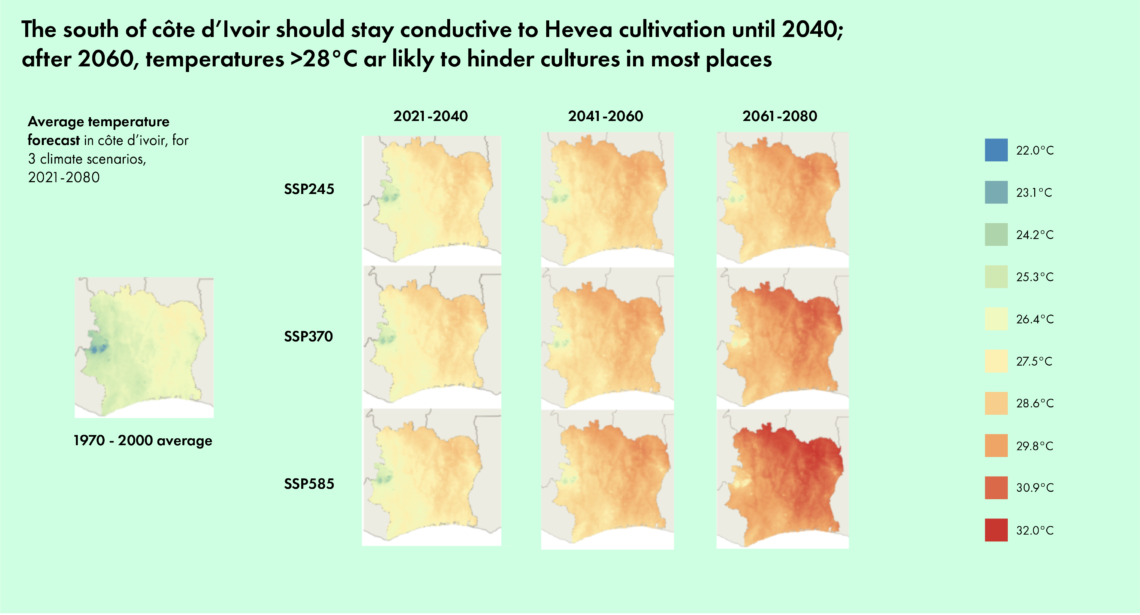
Average maximum temperature of warmest month in Côte d’Ivoire for 3 climate scenarios, 2021-2080
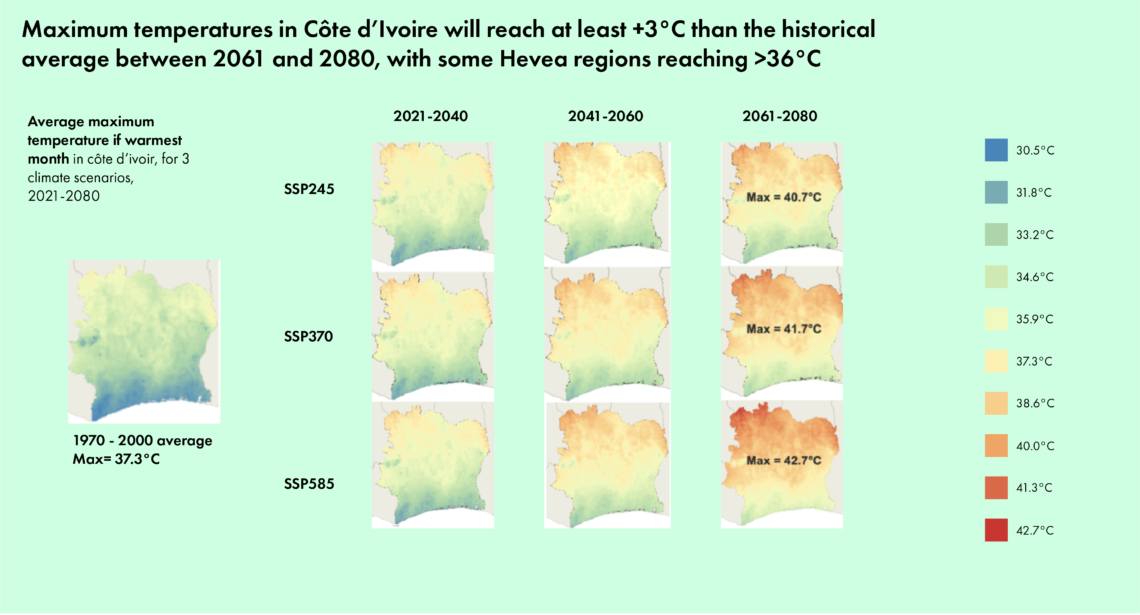
While annual average temperatures in Côte d’Ivoire’s Hevea regions should stay below or close to 28°C until 2040, they are forecast to be higher than 28°C in some areas between 2041 and 2060. Most of them will be at risk of reaching annual average temperatures >28°C after 2061, regardless of the scenario.
Temperatures during the warmest month will rise, which can stunt young trees’ growth and disturb tapping, therefore reducing yields. However, maximum temperatures in Hevea cultivation areas seem to be predicted to rise to levels already observed in the warmest cultivation areas today.
Average annual precipitations forecast in Côte d’Ivoire, for 3 climate scenarios, 2021- 2080
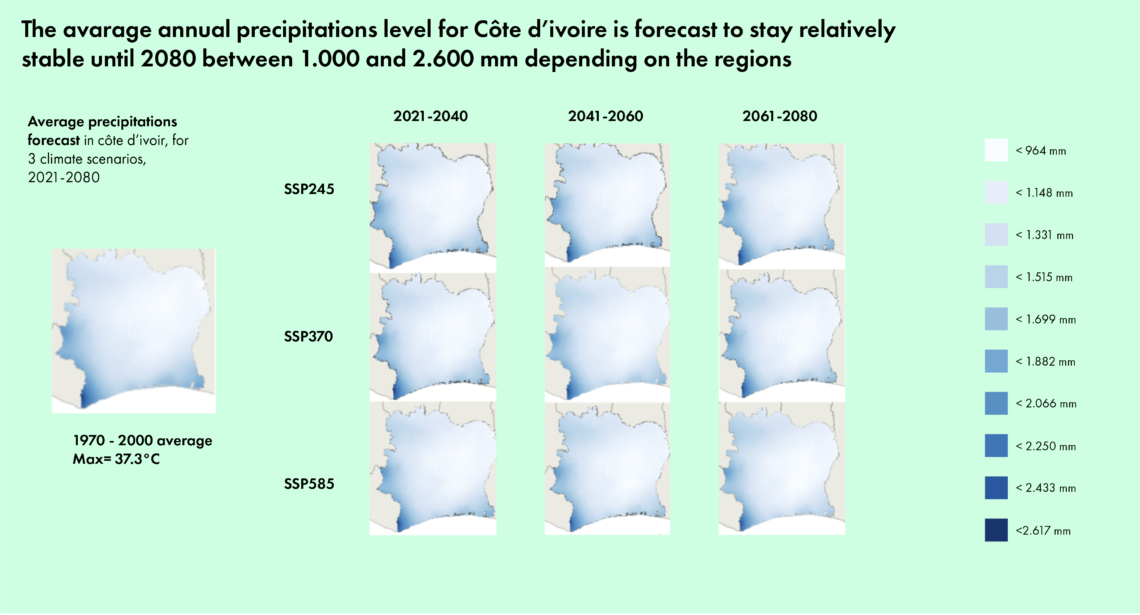
Precipitation seasonality forecast in Côte d’Ivoire, as coefficient of variation, for 3 climate scenarios, 2021-2080
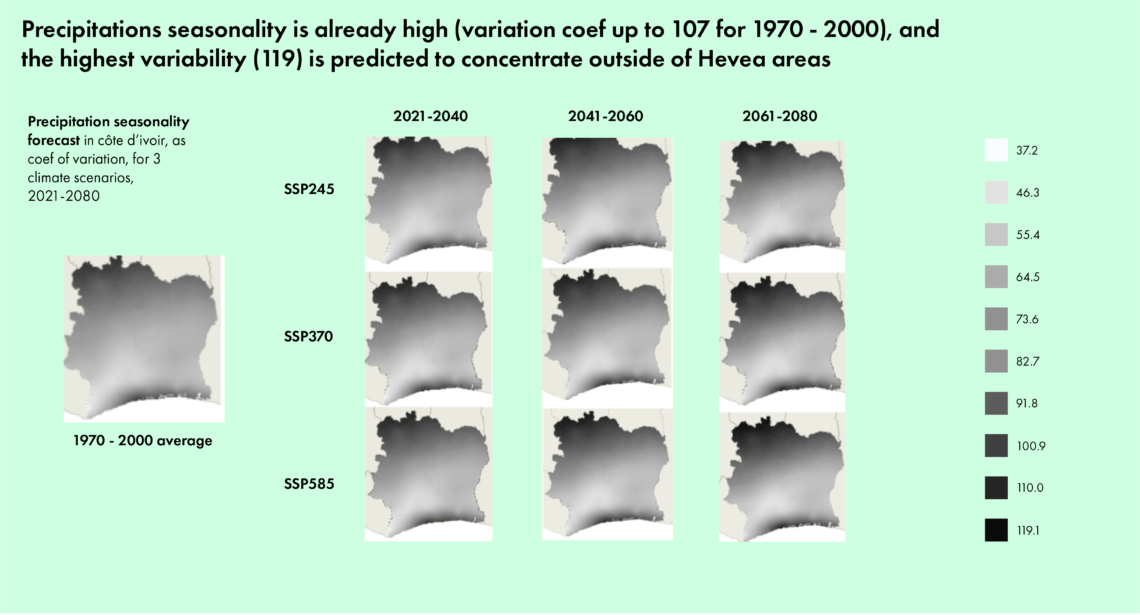
With ideal growing conditions being between 1,400-4,000mm per year, precipitation levels should stay sufficient to support cultivation, especially with climate resilient clones. Moreover, the average annual precipitations are predicted to decrease, which could be favorable to Hevea cultivation, which has been shown to be negatively correlated with rainfalls.26 Additionally, Hevea trees fare well with precipitations’ seasonality, which is already high in Côte d’Ivoire, with variation coef. up to 107 for 1970-2000.
Adaptation: preserving Hevea production
It is important to remember that climate is not the only factor to consider when analyzing the suitability of Hevea cultivation. In addition to temperatures and precipitation, soil quality needs to be assessed.27 The competition and complementarity with other land uses, and particularly palm oil production and protected forests should also be considered.
Besides its economic importance, rubber can potentially play a role in the mitigation of climate change and sustainable development.28
Trees play an important role in the atmospheric CO2 content. Climate change and human activities have resulted in loss of natural forests. It is therefore necessary to restore the forest ecosystem, which in turn require to provide means of economic empowerment of forest communities under a sustainable farm practice. Rubber meets these requirements, giving it a role in the adaptation to climate change, and can help in the restoration of degraded tropical forests.29 Rubber trees can also improve local climate conditions, by reducing the surface temperature in comparison with grassland cover.30
Measures to ensure the sustainability of Hevea culture are31,32:
• Implementing climate resilient agronomic practices, such as partially shading young plants, mulching them, partial irrigation and life-saving irrigation to address increased risks of drought, and intercropping. It can also entail better monitoring and prevention to ensure early intervention against pests and diseases.
• Developing selection to support breeding towards high yielding, climate resilient and disease resistant clones.
• Planning of plantation renewals, based on climate forecast, with expansion to marginal areas where conditions are likely to improve.
Such measures need to be supported by policies. These policies should seek to finance the research for tree selection, encourage the renewal of plantations, and promote new practices and locally specific guidance.33,34 Dr Kenneth Omokhafe, Research Director at the Rubber Research Institute of Nigeria, stresses the importance of spreading awareness of the advantages of intercropping among smallholders, and recommends collaboration with NGOs and donor support funds to this effect. Author: Caroline Desmoulin (Senior consultant)
Do Well Do Good wishes to thank Dr Kenneth Omokhafe, Research Director at the Rubber Research Institute of Nigeria and Dr Eric Penot and his colleagues at CIRAD for their contributions to this article.
- 1 Food and Agriculture Organization of the United Nations database, last available data 2 IRSG, 2024
- 3 Ibid.
- 4 National Statistics Institutes of Côte d’Ivoire
- 5 UN ComTrade database, last available data 6 Ibid.
- 7 Ibid.
- 8 C. Bunn et al., 2014
- 9 J. Jacob et al., Natural rubber contributions to adaptation to climate change, 2020
- 10 S. Pinizzotto et al., Natural rubber and climate change: a policy paper, 2021
- 11 H. Y. Umar et al., Evaluation of impact of climatic factors on latex yield of Hevea Brasiliensis, 2017
- 12 J. Jacob et al., Natural rubber contributions to adaptation to climate change, 2020
- 13 S. Pinizzotto et al., Natural rubber and climate change: a policy paper, 2021
- 14 R. Golbon et al., 2018
- 15 H. Y. Umar et al., Evaluation of impact of climatic factors on latex yield of Hevea Brasiliensis, 2017
- 16 J. Jacob et al., Natural rubber contributions to adaptation to climate change, 2020
- 17 Ibid.
- 18 Omokhafe, K. O., Emuedo, O. A. (2006) Evaluation of influence of five weather characters on latex yield in Hevea brasiliensis. International Journal of Agricultural Research, 1: 234 – 239.
- 19 Chen et al., 2021
- 20 Febbiyanti, 2021 & Nghia, 2021, in S. Pinizzotto, A. Aziz, V. Gitz, J. Sainte-Beuve, L. Nair, E. Gohet, E. Penot and A. Meybeck. 2021. Natural rubber systems and climate change:
- 21 J. Jacob et al., Natural rubber contributions to adaptation to climate change, 2020
- 22 S. Sdoodee and Sopon Rongsawat, 2012
- 23 J. Jacob et al., Natural rubber contributions to adaptation to climate change, 2020
- 24 A. Benoist and A. Leconte, CIRAD, FIRCA and APROMAC, 2020
- 25 Ibid.
- 26 C.S. Mesike and T.U. Esekhade, Rainfall variability and rubber production in Nigeria, 2014
- 27 M.H.M. Hazir et al., Effect of agroclimatic variability on land suitability for cultivating rubber, 2020
- 28 Ibid.
- 29 K. O. Omokhafe, The place of the rubber tree (Hevea brasiliensis) in climate change, 2020
- 30 Natural rubber contributions to adaptation to climate change, J. Jacob et al., 2020
- 31 S. Pinizzotto et al., Natural rubber and climate change: a policy paper, 2021
- 32 J. Jacob et al., Natural rubber contributions to adaptation to climate change, 2020
- 33 Ibid.
- 34 S. Pinizzotto, A. Aziz, V. Gitz, J. Sainte-Beuve, L. Nair, E. Gohet, E. Penot and A. Meybeck, Natural rubber systems and climate change, 2021

